Ryan Hall's Blog, page 192
January 4, 2017
9 Ways to Become Faster in 2017
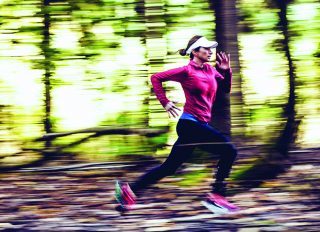
Photo: Istockphoto.com

Maybe 2016 was a banner year; you set PRs in every race you ran. Maybe it was the opposite—a year you’d like to put behind you. Or maybe you’re just stuck in a rut and can’t seem to take your running to the next level. Whatever happened, now it’s time to evaluate what you did well and figure out what you can do better to run faster in 2017.
“Unfortunately, there are no magic bullets,” says Drew Wartenburg, head coach of the NorCal Distance Project elite training group. But there are some specific things you can do immediately.
RELATED: New Year, New You? Only If You Make It Happen
1. Set a goal
The first thing you should do in 2017 is set a goal for 2017. “Train for something out there on the horizon,” Wartenburg says. It doesn’t have to be a race, but it does need to be something that will get you out of bed in the morning and give you a reason to get faster. Maybe that’s running farther than you ever have or trying something you’ve never tried.
“Sign up for an event that’s outside of your comfort zone,” says Magdalena Boulet, a 2008 U.S. Olympic marathoner and winner of the 2015 Western States 100. If you’re a little nervous, you’ll be a little more motivated, she says.

2. Make a plan
Having a goal without a plan is like hoping tomorrow you’ll wake up and suddenly be a sub-3-hour marathoner. Yet, that’s exactly what many of us do, running the same loop around our neighborhood a few times each week, with a tempo and long run here or there, but without any real structure.
You can either look at your goal and plot backward with smaller goals, or you could follow and tweak a generic training plan, or you could simply join a training group with people who have similar goals. “It can also be helpful to hire a coach to help you reach your goals and keep you accountable,” Boulet says. Whatever your plan is, make 2017 the year you have one.
3. Go short and fast
Include variability—different training stresses at different times. But, while people remember to do tempo runs, mile repeats, or even 800m track workouts, they often forget to actually run fast sprints. “People rarely run fast,” says Ben Rosario, coach for the Northern Arizona Elite training group.
Add into your regular workout repertoire: 10 x 20 seconds really fast, then jog easy for 1–2 minutes in between each. Focus on form and turnover. “Picture yourself like you’re Usain Bolt,” Rosario says. Or, Boulet recommends twice each week finishing off an easy run with strides or short hill sprints.
The bouts of speed will improve economy and help engage fast-twitch fibers, which can then be called on later.

4. Warm up first
One thing that can almost definitely be improved is what we’re doing before we even start running. “Warm up to run, don’t run to warm-up,” Wartenburg says. This is especially important if you just rolled out of bed or if you’ve been sitting at a desk all day. Warming up prevents injury and prepares us to run faster.
What does that mean though? A good warm-up will include a few minutes of dynamic active stretching, some lateral movements and muscle activation. Wartenburg recommends finding a dynamic warm-up routine online that you like, such as the popular lunge matrix.
5. Add one more day of running
In a perfect world, Rosario says, most recreational athletes would be running more frequently and more mileage. While there are lots of ways to improve, simply running more is often the most overlooked one. The caveat, of course, is that no one should increase their mileage too quickly, but there’s no reason regular runners can’t be running six days a week, he said—albeit slower or shorter than the professionals.
That may not be realistic with your schedule, but Rosario recommends starting out by just adding one more day of running each week, however short the run is. Then go from there.
6. Change your shoes
One thing you can easily do right now is start varying what shoes you wear for runs. “I always advise people to mix it up a bit, and try alternating between a couple different shoes depending on the run,” Boulet says.
This can help prevent injury simply through variation. Plus, different shoes are good for different types of running. Trail shoes typically provide better traction and light racing shoes are best for fast running.
“In the long run (pun intended) you actually don’t spend more money on shoes, since each pair will last longer if it’s not being run in every day,” Boulet says.
RELATED: How Often Should I Replace My Running Shoes?
7. Run harder on your long runs
One of the regular workouts nearly every runner does is the long easy run. But that doesn’t mean every long run needs to be a slow slog. Many runners would benefit from occasionally mixing up that staple. “We’ve found a lot of success with spicing up that long run and making it harder,” Rosario says.
One option to try in 2017 is to throw in surges throughout, such as making the first few minutes of each mile faster. Or, Roasrio likes to have his athletes finish many of their long runs with three fast miles. The key is for each mile to be faster than the one before, so you finish “and feel good about yourself,” he jokes. Plus, you get to practice pushing through fatigue like in a race situation.

8. Take time off
If we really want to get faster at running, we also have to stop running sometimes. After a half marathon, take a week off, and after a marathon, you should have two weeks off, Rosario says. Time off means zero running, just easy walking or swimming or biking.
Many athletes get too scared they’ll get out of shape, but nearly all injuries, Rosario says, are the result of not recovering enough.
RELATED: The Benefits of Taking a Break from Running
9. Sleep more
After you’re done running, the ways to improve don’t stop. “Outside of running, better recovery and sleeping more are the number-one things,” Wartenburg says. “Sleep is probably better than doubling your mileage in terms of return on investment.”
There’s a reason most professional athletes get close to 10 hours of sleep every night. That’s time your body needs to rebuild muscle fibers and repair cells, especially if you’re putting it through a lot. Resolve in 2017 to carve out time to sleep more—think of it as training time for your next marathon.
Photos: Istockphoto.com
The post 9 Ways to Become Faster in 2017 appeared first on Competitor.com.
January 3, 2017
The Ambition Effect: Setting a Goal Can Change Your Life
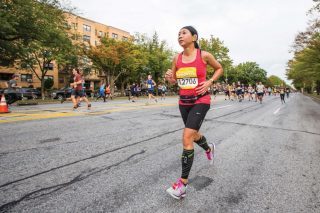
When Carol Chau signed up for her first race, she wasn’t anticipating much to come from it—a medal, she assumed, and perhaps a bit of weight loss. She certainly didn’t expect running to transform her life.
As a newly-hired manager in San Jose, Carol dedicated all of her time to her clients and career. She traveled often for her job, her days filled with meetings and networking. For years, she insisted she didn’t have time to run. Besides, she wasn’t the running type, anyway—she had been a casual runner in her youth, but that was 13 years ago. As an adult, her knees ached and her breath was labored.
But in 2013, that all changed with one simple declaration.
“What got me back into running was my sister Helen. Helen had cancer, and it was a surprise for all of us.” Helen underwent a full recovery, and began focusing on her health. “My sister told me she was running a 10K in Hong Kong,” recalls Carol, “and that sparked my interest. I remember saying, ‘Someday, I would like to be able do that.’”
Carol set a goal to make “someday” a reality. First, she saw her doctor to address the knee pain that had kept her from exercising. After that, she found a way to work a training plan into her busy schedule. Finally, she entered a race.
At the finish line of that first race, Carol gleefully sent a selfie to her sister in Hong Kong. They immediately began planning to race a 10K together. A third sister decided to join them as well, and Carol enjoyed their daily group chat of workout summaries, training advice, and selfies at races. An ocean separated her family, but a love of running bridged the gap.
Since that fateful phone call with her sister, Carol has run dozens of races. Her knee pain is gone, she is in the best physical shape of her life, and Carol has even inspired her co-workers to take up running and find time for wellness.
Today, Carol will tell you she still doesn’t have the time to run—she makes the time to run. “Running has certainly changed how I organize my schedule. When I run, I don’t check my emails. Yet somehow, I am able to accomplish more than just sitting in my office doing my job every day.”
Carol’s ambition to be a runner has improved all areas of her life. The processes of working forward—establishing a goal, coming up with a plan, and finding the right resources—have helped her succeed in running and beyond.
“I want to be in the best physical and mental health I can be. Running helps with my self-confidence, stamina and endurance, which makes me better at my job and my life.”
The post The Ambition Effect: Setting a Goal Can Change Your Life appeared first on Competitor.com.
January 2, 2017
Video: Patriots Day Movie Official Trailer

The 2013 Boston Marathon will always be remembered for the terrorist bombings that eventually took the lives of four people and permanently injured hundreds more. “Patriots Day” debuted in theaters on Dec. 21, depicting both the finish line chaos of that day and also the three-day manhunt that followed. In the aftermath of the attack, police Sgt. Tommy Saunders (Mark Wahlberg), FBI Special Agent Richard DesLauriers (Kevin Bacon) and Commissioner Ed Davis (John Goodman) join courageous survivors, first responders and other investigators in a race against the clock to hunt down the suspects and bring them to justice.
The post Video: Patriots Day Movie Official Trailer appeared first on Competitor.com.
New Year, New You? Only If You Make It Happen
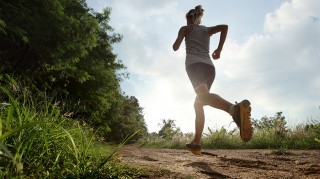
January is considered a month for resolve, renewal and rejuvenation. Oh, and resolutions too. But that’s a lot of pressure. Instead of making daunting, unrealistic or too-easily-broken resolutions, set reasonable goals and take action to achieving those objectives and put yourself on a consistent path for an epic year.
RELATED: New Runner—Everything You Need to Know to Get Started
Set Goals
Make a long-term plan for what you want to accomplish in the spring, summer or fall—whether that means getting fit for a half-marathon, running your fastest marathon, planning a vacation around a destination race or tackling your first 50-mile ultra—and then set out smart steps it will take to get you there. Maybe your goal is to get fit, lose 10 pounds and get stoked about how you look and feel everyday. That’s great too, but it’s not going to happen on its own. You need to make a plan and get after it!
RELATED: Maximize Your Metabolism to Keep Weight-Loss Goals on Track
RELATED: 16 Weeks to Your First 50K
Take Action
Start this week! Commit to those goals. Download a training program. Join a weekly running group. Hire a coach. Sign up for fitness classes. Buy new running shoes. Do 100 sit-ups every morning as soon as you wake up. Just start doing it. Right now. Then you can add some push-ups. And yoga twice a week. Don’t wait until the first week of January zips by. The bottom line is that there is no magic bullet, no fancy new workout and no next-generation digital app that is going to help you reach your goals. The only path is through hard work, relentless dedication and living a healthy, balanced life. Only you can control your destiny, so get after it!
RELATED: Do You Need a Running Coach?
RELATED: How to Beat 6 Common Running Excuses
Be Consistent
Work, school, family and daily tasks can get in the way, but only if you allow it. Plan your week around specific daily workout times and make it happen. Aside from long weekend runs and races, it really only takes an hour a day (or sometimes even less) to put you on the path to achieving your goals. It won’t happen unless you make it happen on a regular basis.
I have an old Nike T-shirt with a slogan that reminds me that what we do is pretty simple: “Eat right. Get plenty of sleep. Go like hell.” That sums it up right there. Set goals, take small steps and be relentless in your pursuit in the new year.
RELATED: 7 Ways to Become a Faster Runner Right Now
The post New Year, New You? Only If You Make It Happen appeared first on Competitor.com.
Hoka Launches New Elite ‘Evo Time to Fly’ Team for 2017
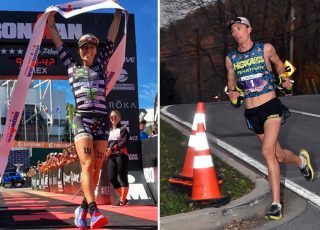
Champion triathlete Heather Jackson and record-setting ultrarunner Jim Walmsley are the headliners of Hoka's new elite athlete team. Photos: Rowan Waldman/Ironman (Jackson) and Mike O'Grady (Walmsley)
When it comes to running, one of the things the new year means is running brands unveiling their new teams of athletes for the competitive seasons on the horizon.
Most pro runner endorsement contracts end on Dec. 31, which means there’s usually a mad scramble among athletes and sports marketing officials at shoe companies this time of the year. But it’s more than just signing fast runners with good times and race results. Connecting with athletes who have the ability to share their experiences via social media and with the company’s product team, as well as having a personality and character traits that can best represent the brand, are also important.
Hoka One One, a brand born in the world of trail running and ultrarunning, has continued to push the boundaries with the help from its elite athletes in those sports, as well as other running-related disciplines. On Jan 3, it will officially announce the launch of its new EVO Time to Fly elite team—an international squad that includes a cross-section of world-class trail and road runners, track athletes and triathletes.
The star-studded team that will serve as global brand athletes includes Ludovic Pommeret (France), the 2016 Ultra-Trail du Mont-Blanc champion; Magdalena Boulet (U.S.), a 2008 U.S. Olympic marathoner and champion ultrarunner; Leo Manzano (U.S.), the 2012 Olympic silver medalist in the 1,500-meter run; Charlotte Morel (France), a national champion triathlete; Sage Canaday (U.S.), a two-time Olympic Trials Marathon qualifier and champion ultrarunner; Heather Jackson (U.S.), a champion triathlete and third-place finisher at the 2016 Ironman World Championships; and Jim Walmsley (U.S.), an ultrarunner who set several records in 2016, including the JFK 50-miler and the Grand Canyon rim to rim to rim FKT. A few more athletes could be added to the team soon.
“The EVO Time to Fly team features some of the best international athletes in every discipline of running—road, trail and track,” said Mike McManus, Hoka One One Global Sports Marketing Manager, who will be managing the team. “We’ve carefully selected athletes that continually challenge the status quo and proudly represent our brand as ambassadors who inspire others.”
RELATED: Jim Walmsley Shatters Grand Canyon Rim to Rim to Rim FKT
Hoka also announced the signing of nine top American trail runners to its domestic team of athletes. Those signees—Chris Vargo, Alicia Vargo (formerly Shay), Tim Tollefson, Megan Roche, David Roche, Cole Watson, Jared Hazen, Patrick Reagan and Sabrina Little—have all made their mark at prominent trail and road races from 5K to 100 miles over the past several years. They join the already rich roster of athletes the includes 2016 record-setters Mike Wardian (new Marathon Majors record), Karl Meltzer (new Appalachian Trail record) and Pete Kostelnick (new trans-U.S. record), just to name a few.
While the brand will help develop footwear and other products for those athletes, the notion of creating elite-level gear just for a select few is too narrow of a concept, said McManus, who joined Hoka last year after more than 20 years at adidas. The bigger goal is to utilize the input and experiences of those athletes to continue to innovate and build better shoes for all runners, he added.
While many companies talk about using athlete input, not too many have really taken that input and used it constructively to innovate or adapt products. (Ultimate Direction, New Balance, Oiselle, Salomon, Nike and Altra are a few of the others that have shown results from athlete-led innovation.)
“One of the really cool things that has happened internally is the interaction our athletes have had with our product team and their ability to share the unique disciplines they come from,” McManus said. “In some cases, there is huge crossover but in other cases the athletes that are very, very different and unique, and yet both are important to us as a brand. The insights they’re able to give our product team will help us maximize our product from an innovation standpoint, but it also helps influence the direction of our company.”
The hard-fought experiences of those athletes can provide authentic input regarding comfort, performance and durability over a relatively short period of time during a race and from their history of competition. McManus said even though some of the athletes race as short as 4 minutes and some race more than 20 hours in different disciplines, there is some interesting overlap and synergy. For example, Jackson is an Ironman triathlete who typically runs in her Hokas after spending 5 hours or more swimming and cycling while Boulet is an ultrarunner who usually runs races that last from 5 to 20 hours.
McManus was quick to point out that it’s a two-way street. While Hoka gets valuable input and exposure, the brand encourages and helps the athletes achieve their goals, whether it’s winning races or going after new records or FKTs. And the athletes on the team help motivate each other, too.
“The interaction between a guy like track athlete Kyle Merber and ultrarunner Jim Walmsley was really something we didn’t expect,” he said. “There was a real interest and cool vibe between those guys, even though one is a fast miler on the track and the other is trying to do amazing things over extreme distances. It’s that kind of interaction and both similarities and differences that will help push us in our innovation.”
RELATED: Karl Meltzer Sets New Appalachian Trail Record
The post Hoka Launches New Elite ‘Evo Time to Fly’ Team for 2017 appeared first on Competitor.com.
January 1, 2017
An Easier Way to Become a Better Fat Burner
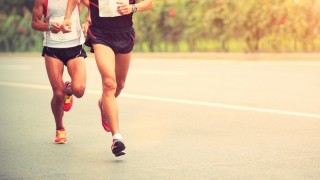
In the fall of 2015, ultrarunner and blogger Matthew Laye placed himself on a high-fat, low-carbohydrate (HFLC) diet. He got 70 percent of his daily calories from fat and limited his carbohydrate intake to 50 grams per day or less. Laye had read that, by doing this, he would teach his muscles to burn more fat and less carbohydrate when he ran, and his endurance would increase. He embarked upon his HFLC diet journey with high hopes.
Those hopes didn’t last long. Many runners feel lousy for a while as they adapt to a HFLC diet. But Laye never stopped feeling lousy. “I was running nearly a minute [per] mile slower than my normal easy pace,” he reported on his blog. “Fast and hilly running, when I occasionally attempted them, were [nearly] impossible.” Worse, when Laye had blood work done, he discovered that his LDL (“bad”) cholesterol level had skyrocketed. He quit the diet.
Laye’s experience is very common. Many if not most runners who experiment with HFLC diets feel lousy, get slower, and suffer health consequences. Others report positive results, but even for them there are costs, including an unpleasant and disruptive transition period and tremendously restricted food and meal options.
Fortunately, recent science is showing that it’s possible to gain the benefits of HFLC without the consequences through alternative methods that are much less extreme. Specifically, the practice of performing select workouts in a carbohydrate-deprived state has been proven to provide an extra fitness boost—even for athletes who are already fit.
The latest scientific support for this practice comes from a study conducted by researchers at the French National Institute of Sport (FBIS) and published in the respected journal Medicine & Science in Sports & Exercise. The subjects were 21 well-trained triathletes, who were separated into two groups. Both groups were placed on relatively high-carb diets that supplied six grams of carbohydrate per kilogram of bodyweight daily. But on four days of each week, the members of one group got all of their carbs from their first two meals of the day and ate no carbs at dinner. These carb-free dinners followed an intense interval workout that members of the other group also performed.
The morning after the interval workout, all of the subjects completed an easy one-hour workout before breakfast. This workout was done in a mildly carbohydrate-deprived state by the triathletes who had followed the previous day’s interval session with a normal dinner but was done in a severely carbohydrate-deprived state by those who had followed the same workout with a zero-carb dinner.
These dietary and training patterns were kept up for three weeks. All of the subjects completed performance tests before and after this 21-day period. Members of the group that practiced carb-fasted training saw significant improvements in cycling efficiency, high-intensity cycling performance, and running performance within a triathlon time trial. There were no such improvements among members of the other group.
It’s important to note that high-fat diets and other low-carb diets have never been linked to performance gains in tests like these. In fact, they have repeatedly been linked to performance decrements including loss of anaerobic power, decreased VO2 Max, and reduced time-trial performance. That’s at least partly because the improvement in fat-burning capacity that comes from eating HFLC is counteracted by loss of carbohydrate-burning capacity, which is at least as important. But the subjects of the FNIS study (or half of them, at least) got the best of both worlds: a general diet that was high in carbohydrate to support maximum performance in hard workouts combined with the opportunity to gain the advantages of doing some easier workouts in a carbohydrate-deprived state.
The results of this study should not be taken to indicate that all athletes must follow precisely the same protocol to obtain the benefits of carb-fasted training. In fact, the protocol was a little weird, featuring high-intensity interval workouts on four consecutive days for three straight weeks—something that no successful endurance athlete I’m aware of does in the real world. I suspect that you can benefit just as much from employing the sequence of high-intensity afternoon workout/no-carb dinner/sleep/easy pre-breakfast workout just once or twice a week over a longer time period.
Also, as a nutritionist, I don’t like to see athletes or anyone else eat no-carb meals very often. The only natural foods that contain zero carbohydrate are meat, fish, and eggs. An all-meat/fish/egg dinner is not exactly nutritionally balanced.
An alternative to the protocol used in the FNIS study that does not require zero-carb meals is the early-morning endurance workout. Used more often by elite athletes, this approach entails doing a long, low-intensity workout either before breakfast or after a light, no-carb breakfast (e.g., a hardboiled egg and black coffee) and during which only water is consumed. You might want to consider alternating this type of workout with the FNIS protocol, employing one of the two formats this week, the other next week, and so on.
There’s no need to get too scientific in incorporating carb-fasted training into your race preparations. Just make it a regular, minor element of your routine in a way that fits your lifestyle. Indeed, it’s worth noting that Kenya’s elite runners practice carb-fasted training for reasons that have everything to do with lifestyle and nothing to do with science. The typical elite Kenyan runner does the first of his or her two to three daily runs before breakfast every day, a habit that may be an underappreciated factor in Kenya’s dominance of the sport. It’s also worth noting that elite Kenyan runners eat more carbohydrate overall than do runners of any other nation except their only true rivals, the Ethiopians: 10 grams per kilogram of bodyweight per day, or 76 percent of total calories. Like I said: The best of both worlds.
The post An Easier Way to Become a Better Fat Burner appeared first on Competitor.com.
Runners: An Easier Way to Become a Better Fat Burner

In the fall of 2015, ultrarunner and blogger Matthew Laye placed himself on a high-fat, low-carbohydrate (HFLC) diet. He got 70 percent of his daily calories from fat and limited his carbohydrate intake to 50 grams per day or less. Laye had read that, by doing this, he would teach his muscles to burn more fat and less carbohydrate when he ran, and his endurance would increase. He embarked upon his HFLC diet journey with high hopes.
Those hopes didn’t last long. Many runners feel lousy for a while as they adapt to a HFLC diet. But Laye never stopped feeling lousy. “I was running nearly a minute [per] mile slower than my normal easy pace,” he reported on his blog. “Fast and hilly running, when I occasionally attempted them, were [nearly] impossible.” Worse, when Laye had blood work done, he discovered that his LDL (“bad”) cholesterol level had skyrocketed. He quit the diet.
Laye’s experience is very common. Many if not most runners who experiment with HFLC diets feel lousy, get slower, and suffer health consequences. Others report positive results, but even for them there are costs, including an unpleasant and disruptive transition period and tremendously restricted food and meal options.
Fortunately, recent science is showing that it’s possible to gain the benefits of HFLC without the consequences through alternative methods that are much less extreme. Specifically, the practice of performing select workouts in a carbohydrate-deprived state has been proven to provide an extra fitness boost—even for athletes who are already fit.
The latest scientific support for this practice comes from a study conducted by researchers at the French National Institute of Sport (FBIS) and published in the respected journal Medicine & Science in Sports & Exercise. The subjects were 21 well-trained triathletes, who were separated into two groups. Both groups were placed on relatively high-carb diets that supplied six grams of carbohydrate per kilogram of bodyweight daily. But on four days of each week, the members of one group got all of their carbs from their first two meals of the day and ate no carbs at dinner. These carb-free dinners followed an intense interval workout that members of the other group also performed.
The morning after the interval workout, all of the subjects completed an easy one-hour workout before breakfast. This workout was done in a mildly carbohydrate-deprived state by the triathletes who had followed the previous day’s interval session with a normal dinner but was done in a severely carbohydrate-deprived state by those who had followed the same workout with a zero-carb dinner.
These dietary and training patterns were kept up for three weeks. All of the subjects completed performance tests before and after this 21-day period. Members of the group that practiced carb-fasted training saw significant improvements in cycling efficiency, high-intensity cycling performance, and running performance within a triathlon time trial. There were no such improvements among members of the other group.
It’s important to note that high-fat diets and other low-carb diets have never been linked to performance gains in tests like these. In fact, they have repeatedly been linked to performance decrements including loss of anaerobic power, decreased VO2 Max, and reduced time-trial performance. That’s at least partly because the improvement in fat-burning capacity that comes from eating HFLC is counteracted by loss of carbohydrate-burning capacity, which is at least as important. But the subjects of the FNIS study (or half of them, at least) got the best of both worlds: a general diet that was high in carbohydrate to support maximum performance in hard workouts combined with the opportunity to gain the advantages of doing some easier workouts in a carbohydrate-deprived state.
The results of this study should not be taken to indicate that all athletes must follow precisely the same protocol to obtain the benefits of carb-fasted training. In fact, the protocol was a little weird, featuring high-intensity interval workouts on four consecutive days for three straight weeks—something that no successful endurance athlete I’m aware of does in the real world. I suspect that you can benefit just as much from employing the sequence of high-intensity afternoon workout/no-carb dinner/sleep/easy pre-breakfast workout just once or twice a week over a longer time period.
Also, as a nutritionist, I don’t like to see athletes or anyone else eat no-carb meals very often. The only natural foods that contain zero carbohydrate are meat, fish, and eggs. An all-meat/fish/egg dinner is not exactly nutritionally balanced.
An alternative to the protocol used in the FNIS study that does not require zero-carb meals is the early-morning endurance workout. Used more often by elite athletes, this approach entails doing a long, low-intensity workout either before breakfast or after a light, no-carb breakfast (e.g., a hardboiled egg and black coffee) and during which only water is consumed. You might want to consider alternating this type of workout with the FNIS protocol, employing one of the two formats this week, the other next week, and so on.
There’s no need to get too scientific in incorporating carb-fasted training into your race preparations. Just make it a regular, minor element of your routine in a way that fits your lifestyle. Indeed, it’s worth noting that Kenya’s elite runners practice carb-fasted training for reasons that have everything to do with lifestyle and nothing to do with science. The typical elite Kenyan runner does the first of his or her two to three daily runs before breakfast every day, a habit that may be an underappreciated factor in Kenya’s dominance of the sport. It’s also worth noting that elite Kenyan runners eat more carbohydrate overall than do runners of any other nation except their only true rivals, the Ethiopians: 10 grams per kilogram of bodyweight per day, or 76 percent of total calories. Like I said: The best of both worlds.
The post Runners: An Easier Way to Become a Better Fat Burner appeared first on Competitor.com.
December 28, 2016
Epic Adventure: Running Around Mont Blanc in 6 Amazing Days
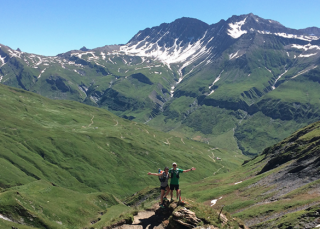
After seeing so many photos and videos about trail running in the Alps in and around Chamonix, France, for the past several years, we decided to plan an epic multi-day running trip of our own in the summer of 2016. The gallery of images below shows some of the scenes that tell the story of our amazing six-day odyssey.
RELATED: Tips on Planning an Epic Multi-Day Run Around Mt. Blanc
Photo Gallery
1 of {count}
Back to Start
View Larger Image

We took trains from Geneva to Chamonix and arrived at the train station to find breathtaking views. Photo: Chris Smith
View Larger Image
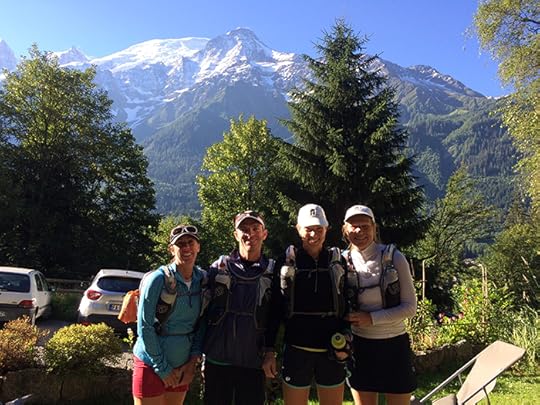
Here we go! This was taken at the Chalet Hotel Les Campanules in Les Houches on our first morning out on the trails. Photo: Marianne Martin
View Larger Image
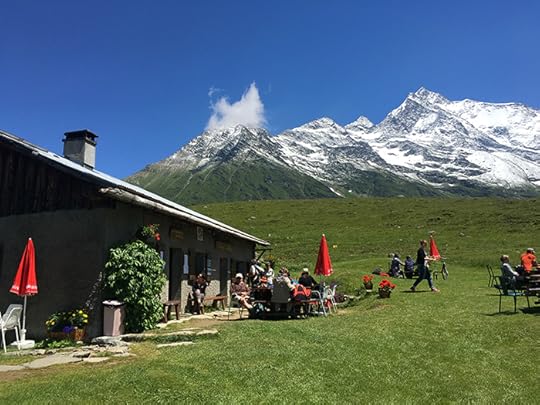
A typical lunch spot along the trail, Auberge du Truc, on the first day near the town of Les Contamines.
View Larger Image

On our first day, we caught this view of Domes de Miage in the background near Les Contamines. Photo: Marianne Martin
View Larger Image

Enjoying post run beers at our first night’s accommodation, Refuge de Nant Borrant. Photo: Chris Smith
View Larger Image

Here on the second morning, we're approaching Elisabetta. Photo: Marianne Martin
View Larger Image

This is near one the top of one of the highest points on the trail, the Col des Fours at 2,665 meters or 8,743 feet. Photo: Chris Smith
View Larger Image
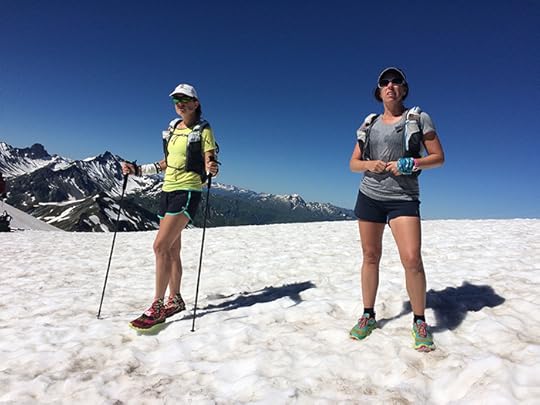
On the top of the the Col des Fours on Day 2. Photo: Marianne Martin
View Larger Image
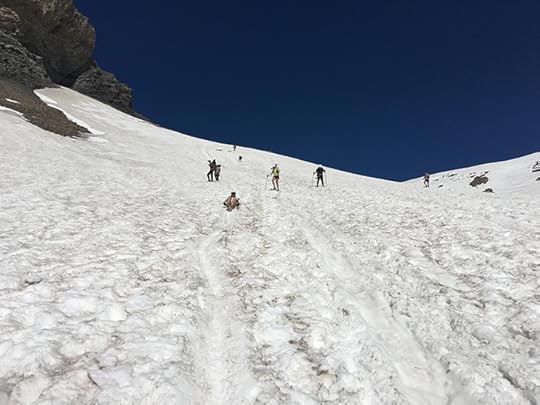
Glissading down the snow bank from the Col des Fours. Photo: Chris Smith
View Larger Image

The decent from the Col des Fours toward Ville des Glacier on Day 2. Photo: Marianne Martin
View Larger Image

Lots of glaciers on the peaks meant lots of stream crossings. Photo: Chris Smith
View Larger Image

The trail is very well marked! The distances are given in time, not distance, which was a bit weird. We quickly figured out the times were conservative estimates for hikers. Photo: Chris Smith
View Larger Image
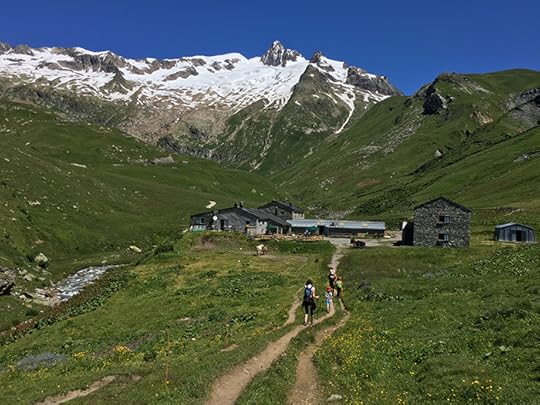
Another fine lunch spot on the second day of our adventure, Refuge des Mottets. Photo: Chris Smith
View Larger Image
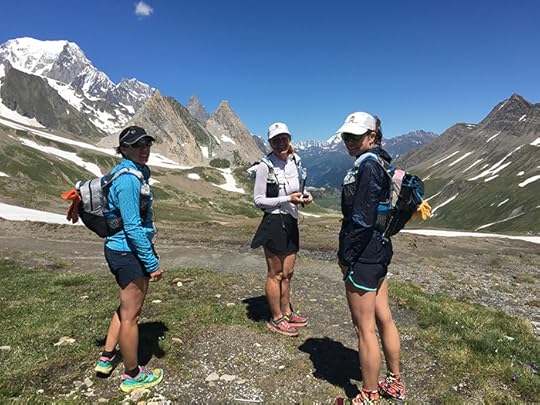
Amy, Marianne, and Michelle enjoying the view from Col de la Seigne, on the border between France and Italy. Photo: Chris Smith
View Larger Image

On the second day, we crossed the Col de la Seigne, leaving France and heading into in Italy. Photo: Marianne Martin
View Larger Image
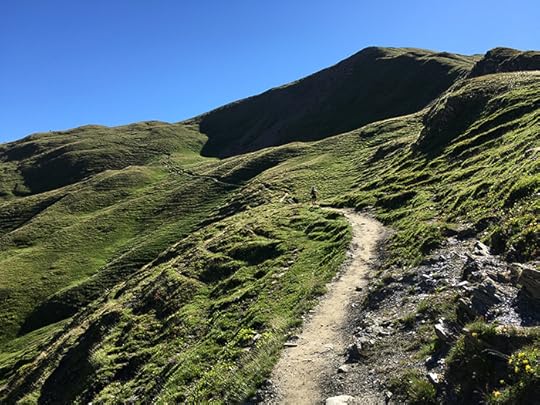
The incredible trail on the way to Courmayeur on the hillsides above the Val Veni. Photo: Chris Smith
View Larger Image
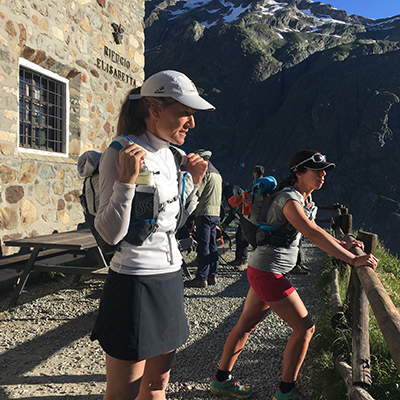
Starting the third day after a great night’s stay at Rifugio Elisabetta in Italy.
View Larger Image
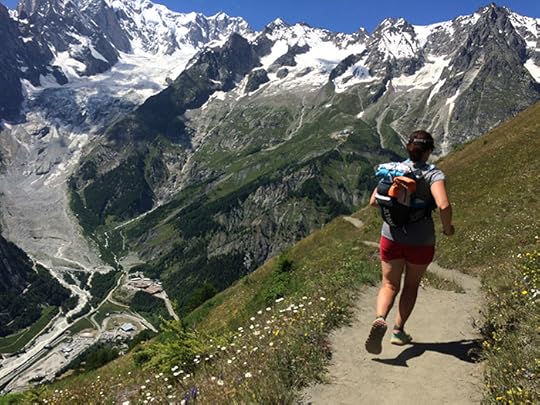
Above the ski resorts outside of Courmayeur, Italy on Day 3. Photo: Marianne Martin
View Larger Image

The incredible views as the trail snakes along the Mont de la Saxe on our way to Rifugio Bonatti. Photo: Chris Smith
View Larger Image
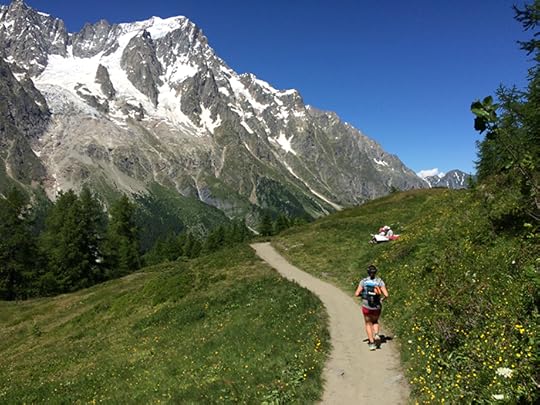
Approaching Bonatti, running along the Mont de la Saxe. Photo: Marianne Martin
View Larger Image
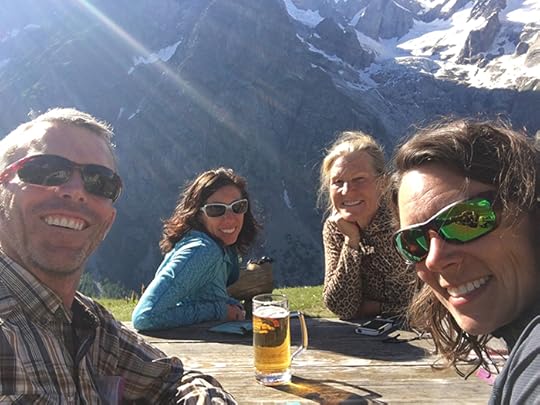
Well-earned beers on the deck of Rigugio Bonatti. Photo: Chris Smith
View Larger Image

This is the Italian refuge hut at Bonatti, where we stayed after our third day of running. Photo: Marianne Martin
View Larger Image
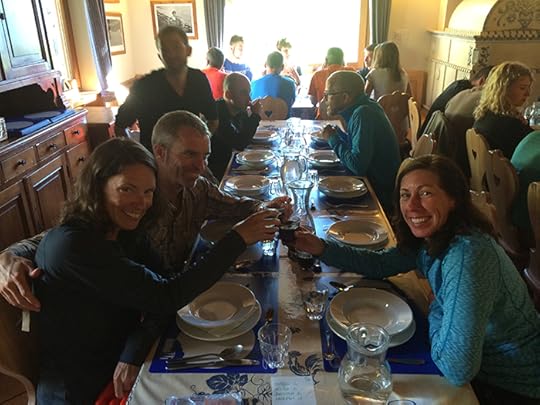
Celebrating our third day of running at the at the Bonatti lodge. Photo: Marianne Martin
View Larger Image
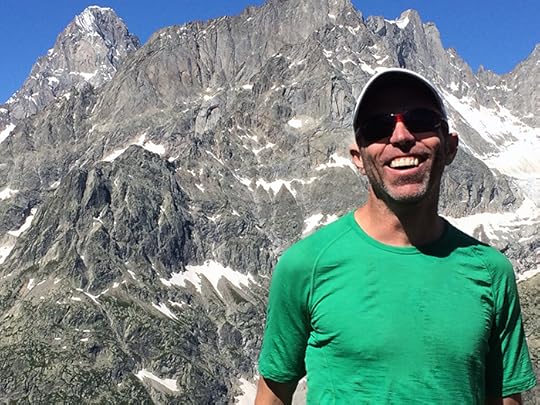
We started our fourth day from Bonatti in Italy and were stoked with this view of Monte Bianco (as the Italians call it) across the Val Feret. Photo: Marianne Martin
View Larger Image
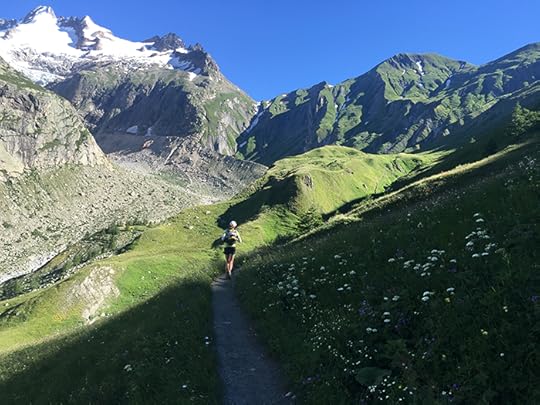
Climbing the Grand Col Ferret, the pass where we cross from Italy into Switzerland. At 2,490 meters or 8,169 feet, it's one of the highest points on the TMB route. Photo: Chris Smith
View Larger Image
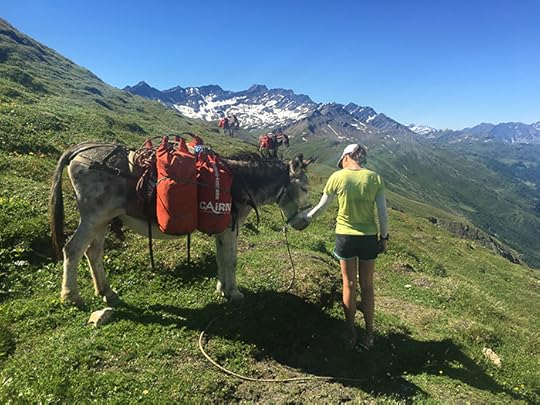
On the Grand Col Ferret, some tour groups offer pack donkeys to lighten the load. Photo: Chris Smith
View Larger Image
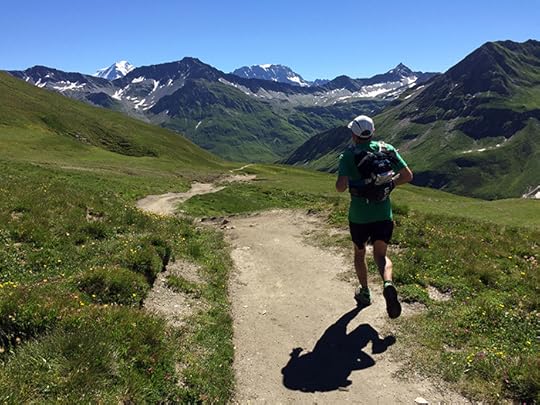
After coming off the Grand col Ferret, we entered Switzerland, our third country in our tour. Photo: Marianne Martin
View Larger Image

Running down the gentle but relentless slopes of the Grand Col Ferret into Switzerland. Photo: Chris Smith
View Larger Image
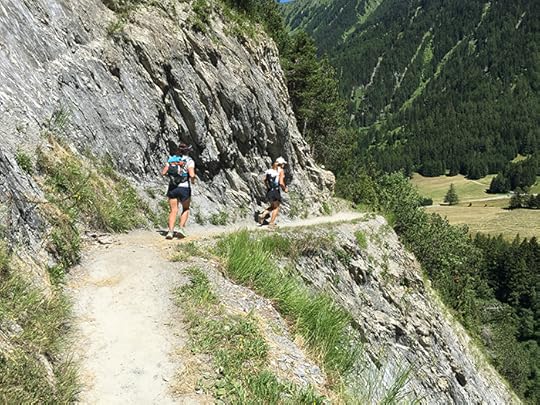
The trails were in great shape in Switzerland, but chains along the cliff face were available for use if the drop offs scared you. Photo: Chris Smith
View Larger Image

Comparing notes with one of the friendly TMB hikers in Orsières, Switzerland. Photo: Chris Smith
View Larger Image
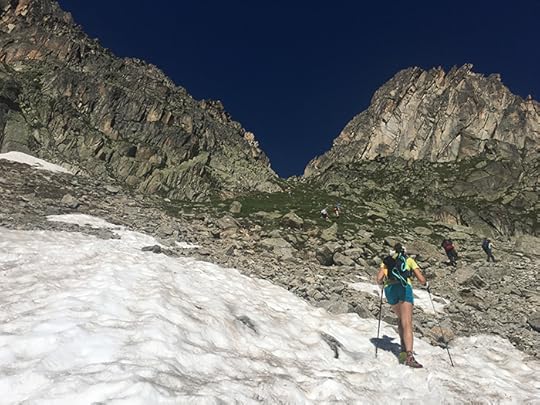
The intimidating climb up to the Fenetre d’Arpette heading to the Switzerland-France border at 2,665 meters or 8,743 feet. Photo: Chris Smith
View Larger Image
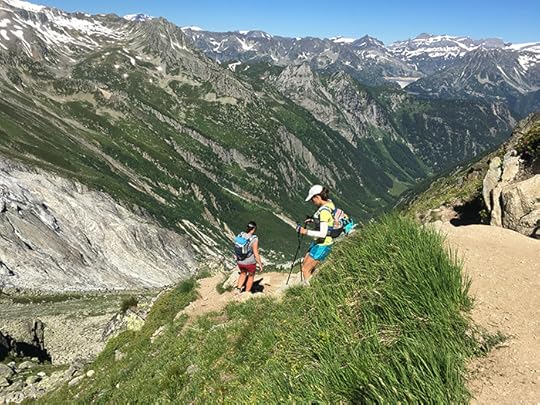
Still in Switzerland, we begin the steep descent from the Fenetre d’Arpette. Photo: Chris Smith
View Larger Image
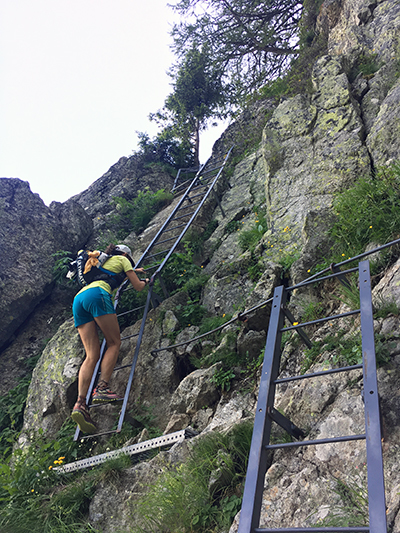
Back in France, we encountered many sets of secure, steel ladders at the base of the Aiguillette d’Argentiere on the way to the scenic Lac Blanc. Photo; Chris Smith
View Larger Image

Near Argentiere, France, we saw this chamois goat with Mont Blanc in the background. Photo: Chris Smith
View Larger Image

This is the first course of an incredible lakeside dinner at Refuge du Lac Blanc at the end of our fifth day. Photo: Chris Smith
View Larger Image
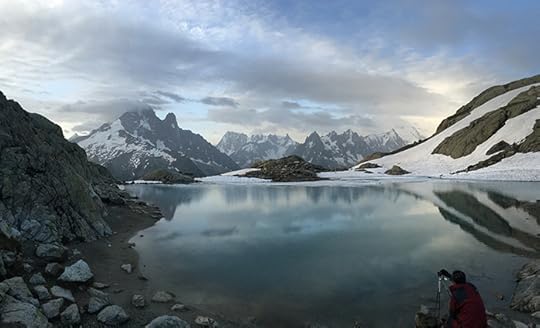
Morning at Lac Blanc, a photographers paradise! Photo: Chris Smith
View Larger Image

On our final day, we were tired and ready to be done. But the views of Mt. Blanc heading into the Chamonix Valley kept us inspired. Photo: Marianne Martin
View Larger Image

Another amazing view of Mont Blanc from across the Chamonix valley. Photo: Chris Smith
View Larger Image
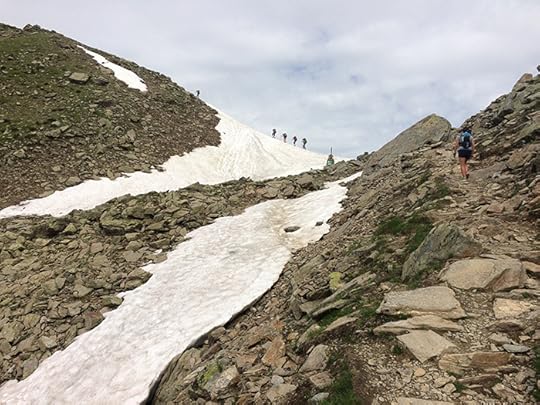
We followed the trails to the Le Brevent ski area high above the Chamonix valley. Photo: Marianne Martin
View Larger Image

A final meal on a sun deck at Le Brevent ski area high above Chamonix. Photo: Marianne Martin
View Larger Image

Aside from being a trail running playground, Chamonix is also a mecca for paragliders. Photo: Marianne Martin
View Larger Image

Before we completed the loop, we tackled another technical section of trail on the ridgeline above Chamonix. Photo: Chris Smith
View Larger Image
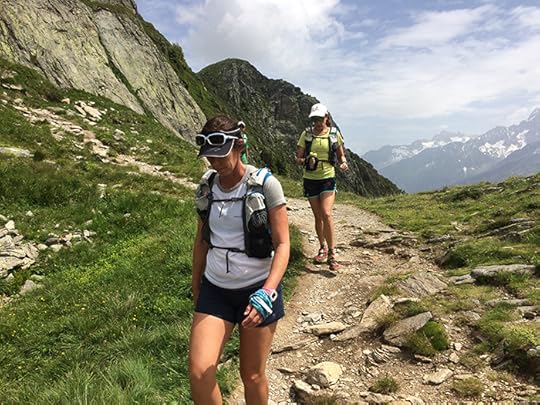
Here we're starting the long decent to Les Houches to complete our epic oddyssey. Photo: Marianne Martin
View Larger Image
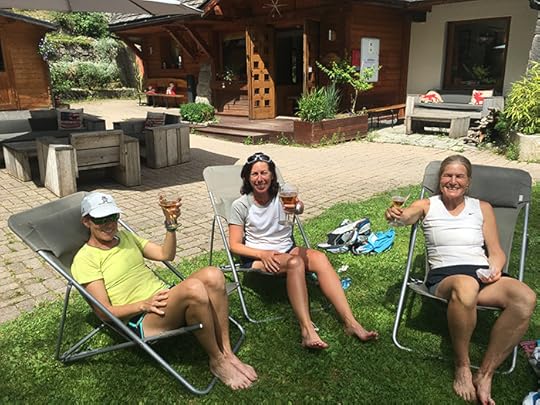
Finished! Celebrating an incredible journey with beers back where we started, Chalet Hotel Les Campanules in Les Houches. Photo: Chris Smith

More Galleries
The post Epic Adventure: Running Around Mont Blanc in 6 Amazing Days appeared first on Competitor.com.
Coach Culpepper: The Benefits of Taking a Break from Running
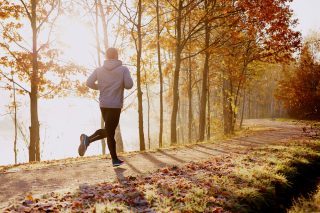
Although there's great satisfaction and many benefits from running consistently throughout the year, it makes sense to take a break from time to time. Photo: Shutterstock.com
There comes a point when we all need to just take a step back and take a break from training. There are a myriad of factors that lead to this becoming necessary whether that be physical or emotional but periodic breaks are an essential component for any appropriate training cycle.
What is important to understand is that a break can and should at times consist of a complete break from running while other times a break should simply be a pause from structured training. Often just taking time off from the rigors of hard workouts, group training sessions or a fixed routine and a shift to purely foundational mileage and no workouts can be just what is needed.
With any effective approach planned or unplanned breaks are necessary. Recognize from the onset that you will need to take a break at some point. The best ones are those that are planned. In most instances a planned break completely off from running for a 1- to 3-week period can help ensure an unplanned break won’t be necessary later when you are not expecting it. The key is recognizing which is appropriate or when a blended model is necessary.
Below is a breakdown of scenarios and which type of break you should consider:
Injury: Not all injuries require time off from running. Taking a week or two off completely is the typical default for most athletes but often you can train through smaller issues. (By all means, if you’re feeling some sort of pain when you run, be sure to see a doctor or physical therpist.) It is possible to train through many minor issues and keep it controlled all while still training. If you have pushed through the injury for months and months and it is just not improving then time off should be considered. The type of injury dictates if time off is appropriate so do more research to learn about this distinction.
Chronic fatigue: Have you ever gotten to the point in your training where you just feel sluggish or that running becomes too laborious? When running starts to feel like a physical burden despite having a pretty good level of fitness, you might be suffering from chronic fatigue. The first approach when dealing with a fatigue pattern that is outside the normal parameters you would expect with hard training, should be a break from hard workouts. A shift to taking a few days off completely then just running for several weeks without workout should be explored first before taking several weeks off completely.
Mental staleness: This scenario pertains to a time when you have a goal but are going through a period where you feel less motivated. It is important to note that the mind needs a break in the same fashion as the body does. Our minds and ability to stay laser-focused on a goal can become fatigued and a break to regroup can help refresh the senses. In this instance, where a goal has been established, shifting to just running mileage for a few weeks and your motivation will come back around.
Lack of clarity of the next goal: This is a common and is different from mental staleness in that you are not sure what to prepare for next and lack motivation due to lack of clarity. If you’re just going through the motions and not really running with purpose, you’re essentially just spinning your wheels. In this situation, taking a full break from running may actually help you regroup and give you that extra incentive to pick a new goal. It can be easy to fall into the pattern or running without purpose and a full break can kick start your thinking more intently on what next challenging you would like to work towards.
Post-racing season: In most instances a complete 1- to 2-week break is appropriate after a racing season. If you have completed a collection of races or trained and finished a marathon then a full break is necessary physically and emotionally. However if you have trained for one particular event but only applied yourself for a few months then reverted back to mileage for a few weeks without workouts is a better approach.
A plateau: Plateaus happen and it can be hard to crack the code as to what to do next to ensure your progress continues. In this scenario reverting to mileage for several months is necessary. In most cases a plateau has happened from the training being too predictable or due to a lack of a base phase. Putting in several months of good foundational mileage could be the physiological element missing and just what is needed to make another step.
The key factor to consider when taking a break is how long and for what purpose. Every aspect of your training should have a purpose including a break. Taking the correct amount can provide just what your body or mind need to regroup and refresh, but too long of a break can have negative implications both physically and mentally. Too long away from training will lead to risk of injury when building back up, taking longer than hoped to get back to prior fitness, frustration emotionally or lack of motivation due to allowing other less productive or positive influences to replace goals and benchmarks.
****
About the Author
Two-time U.S. Olympian Alan Culpepper won national titles from the 5K to the marathon. His first book, “Run Like a Champion,” is available at VeloPress.com.
The post Coach Culpepper: The Benefits of Taking a Break from Running appeared first on Competitor.com.
December 27, 2016
Global Running: Running Adventures Around The World
When planning your 2017 race calendar, consider an international running adventure.
When we think of running, it’s easy to think of it as an individual endeavor in our own terms. We mostly run on the roads and trails where we live, often with our usual running buddies.
But running—and the health and community it fosters—is truly universal. In fact, while soccer, baseball and basketball definitely have international roots and flair, running is arguably the world’s sport—especially from a recreational point of view. With running booming globally, new races popping up all over the place and the rising trend of international running vacations centered around a race and destination trail running trips, the world is becoming a much smaller place for runners. If you’re a runner with a passport and a sense of adventure, the world can truly be your oyster.
Here are a few stories to pique your interest for international running races and adventures.
Key tips and insights for running an international race.
A Go-To Guide To International Racing
Photos from the Ultra Trail Torres del Paine
Global Running—Trail running in Chilean Patagonia
Rock ‘n’ Roll Marathon Series in Mexico City, Madrid, Dublin and Merida in 2017
Rock ‘n’ Roll Marathon Series 2017 Schedule
A multi-day trail run around the Mont-Blanc massif mountain range.
Epic Euro Adventure—Running Around Mont-Blanc
Photos from the Ultra Fiord trail races in Chile
Global Running—Ultra Fiord Trail Races
Scenes from the Affidea Rock ‘n’ Roll Dublin Half Marathon
Photo—Fun Scenes from Rock ‘n’ Roll Dublin
A photo essay from the Ultra-Trail du Mont-Blanc trail running festival in France.
Photos—Amazing scenes from the trail running mecca of Chamonix, France
A trail running photo essay from Italy’s Gargano National Park.
Running Italy’s Gargano National Park
Photos from a running tour of the Costa Brava region of Spain.
Global Running—Running Spain’s Costa Brava
Running across Iceland amid hot springs and geysers.
Global Running—Iceland’s Laugavegur Ultra Marathon
Finding life in the desert at South Africa’s Richtersveld Wildrun.
Global Running—South Africa’s Richtersveld Trail Run
Photos from the Himalayan 100 and Mt. Everest Marathon
Global Running—The Himalayan 100 Stage Race
A photo gallery from an amazing race in Chilean Patagonia.
Photos: Patagonian International Marathon
The post Global Running: Running Adventures Around The World appeared first on Competitor.com.
Ryan Hall's Blog
- Ryan Hall's profile
- 21 followers



